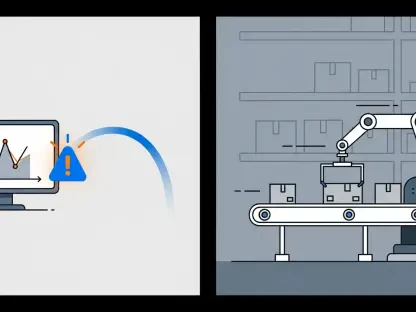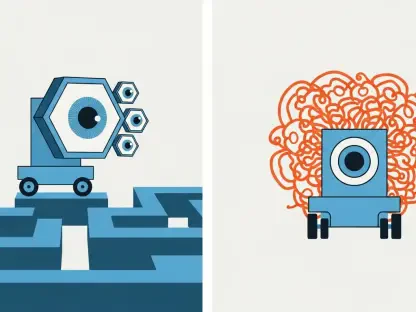In a landscape where speed and precision are paramount, artificial intelligence is reshaping the scientific research domain, promising to usher in an era of unprecedented efficiencies. The unveiling of VISION, an interactive virtual companion, by the U.S. Department of Energy’s Brookhaven National Laboratory signals a transformative shift in how research is conducted. Designed to enhance scientific discovery by employing AI and natural language processing (NLP), VISION is tailored to streamline workflows at scientific user facilities. The core objective is to simplify complex procedures, making research efforts more efficient and accelerating scientific progress. This innovation represents a significant leap forward in AI’s role within scientific circles, underscoring the potential for AI to drastically evolve traditional research methodologies.
Enhancing Scientific Discovery Through AI
The advent of VISION, short for Virtual Scientific Companion, marks a pivotal advancement in the realm of AI-driven research. Specifically engineered to tackle everyday challenges associated with handling intricate scientific instruments, VISION is a voice-controlled AI assistant born from Brookhaven’s collaboration between the Center for Functional Nanomaterials (CFN) and the National Synchrotron Light Source II (NSLS-II). By bridging the gap between technology and practical application, VISION allows researchers to surpass knowledge barriers, optimizing experimental operations and considerably reducing the time spent by scientists. The increasing significance of AI across a multitude of scientific fields has become apparent, with VISION epitomizing the impactful role such technology can play in facilitating scientific breakthroughs.
At the core of VISION’s innovative approach is its proficiency in interpreting spoken commands within a natural language framework. This capability enables it to execute tasks like running experiments, processing data, and visualizing results in real time. Such a user-friendly interface allows researchers to interact with complex scientific instruments effortlessly. The Brookhaven team elaborated these functionalities in a scholarly article in “Machine Learning: Science and Technology,” emphasizing how VISION’s unique attributes aid scientists in performing their duties more effectively. The autonomy VISION introduces could redefine traditional scientific procedures, encouraging researchers to venture into more inventive and intricate problem-solving activities while minimizing repetitive manual tasks.
AI as a Research Partner
One of the key themes surrounding the evolution of AI in research settings is alleviating the mundane tasks that often inundate scientists, thereby liberating them to focus on more critical research endeavors. Esther Tsai, an AI scientist at CFN, intimates the efficacy AI can achieve in refining scientific workflows by eliminating the redundant responsibilities burdening researchers. Serving as an ever-present research partner, VISION can rapidly address typical inquiries related to the functioning of various instruments and their capabilities. This configuration fosters enhanced synergy between researchers and apparatuses, optimizing overall productivity.
Brookhaven Lab’s CFN and NSLS-II exemplify the constructive partnership that facilitates the development and seamless deployment of VISION within experimental settings. This collaborative initiative demonstrates the burgeoning relationship between AI technology and scientific research, validated by empirical testing conducted at experimental sites like the Complex Materials Scattering (CMS) beamline. Voice-controlled experimental setups depict an encouraging depiction of scientific explorations augmented by AI. Consequently, there is a tangible enthusiasm among researchers regarding VISION’s potential, demonstrated by Tsai’s leadership and commitment to the project’s evolution.
Advanced Functionality and Flexible Framework
The robust functionality of VISION is largely enabled by its integration with large language models (LLMs), a technology pivotal to several AI-based interfaces like ChatGPT. LLMs imbue VISION with the capability to generate responsive actions and control codes essential to operating scientific instruments successfully. VISION’s architecture comprises multiple “cognitive blocks” or cogs, each tasked with specific responsibilities, creating a comprehensive system that transparently executes tasks for scientists.
An illustrative example of VISION’s potential is its ability to translate natural language inputs—such as a scientist’s request to set measurement intervals—into executable code. The system incorporates a “classifier” cog to determine task nature, assigning it to the corresponding cog, whether it pertains to instrument control or data analysis. Upon verification, the generated code is executed at the beamline workstation, enhancing operational efficiency by negating the need for detailed manual setups. This innovative approach revolutionizes instrument interaction, enabling researchers to focus on scientific inquiries instead of mastering intricate software systems.
Moreover, the VISION development team remains acutely aware of the continuously evolving AI paradigm. Prioritizing modularity and adaptability ensures that VISION can incorporate emerging AI models seamlessly, effectively future-proofing the system. This design philosophy positions VISION as a forward-thinking tool that evolves alongside contemporary AI advancements, offering a glimpse into the streamlined, efficient workflows of tomorrow’s laboratories.
Bridging AI and Scientific Tools
Historically, CFN and NSLS-II have spearheaded integrating AI and machine learning (ML) technologies into their operational frameworks, supporting autonomous experiments, data analytics, and robotics. VISION represents a logical progression in this evolutionary path. Anticipated future versions of VISION may serve as gateways to more sophisticated AI/ML tools, providing a natural means of interaction with these complex systems. This dual functionality not only empowers researchers but also propels them toward more realized research potentials.
The article also highlights the unprecedented partnership between CFN and NSLS-II, underscoring the practical implications of implementing VISION. This dialogue between AI developers and facility users crafted tailored solutions meeting research demands effectively. VISION’s development journey exemplifies the pioneering nature of AI advancement within the scientific domain, marked by an iterative feedback loop and attentive listening to user experiences for improvement.
User feedback plays a crucial role in VISION’s refinement, as evidenced by the collaboration with CMS lead beamline scientist Ruipeng Li for project deployment. The CMS beamline, annotated as a dynamic arena for testing AI/ML innovations, offers an apt environment for VISION’s ongoing development. Li’s support embodies the shift toward embracing AI within scientific research, acknowledging the transformational benefits AI innovations promise. Engagingly, the feedback loop facilitates a more nuanced understanding of user requirements, actively adapting VISION’s capabilities to real-world research scenarios.
A Vision for the Future of Research
The introduction of VISION, or Virtual Scientific Companion, represents a significant step forward in AI-driven research. This voice-controlled AI assistant emerged from a collaboration between Brookhaven’s Center for Functional Nanomaterials (CFN) and the National Synchrotron Light Source II (NSLS-II). Designed to tackle challenges with intricate scientific instruments, VISION bridges the gap between advanced technology and practical application. It enables researchers to push past knowledge barriers, optimizing experimental procedures and significantly saving time. The growing role of AI in various scientific fields is undeniable, and VISION exemplifies how such technology can drive scientific breakthroughs.
At the heart of VISION’s innovative design is its skill in understanding spoken commands through natural language processing. This ability allows it to perform tasks such as conducting experiments, managing data, and visualizing results instantaneously. This user-friendly system allows researchers to interact effortlessly with complex instruments. In a publication in “Machine Learning: Science and Technology,” the Brookhaven team detailed these functions, underscoring how VISION’s unique features enhance scientific productivity. The autonomy VISION brings could transform traditional procedures, freeing researchers to explore more creative and complex problem-solving while reducing tedious manual tasks.









